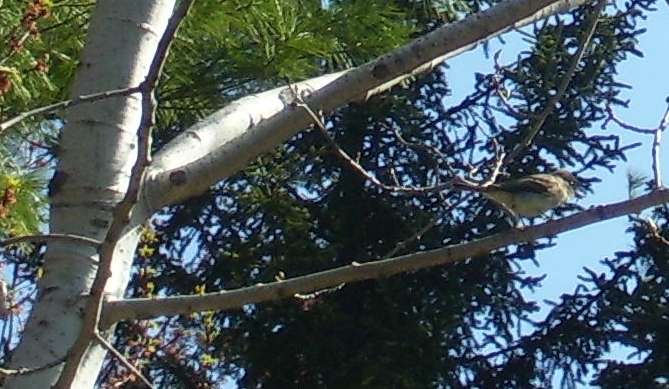The phoebes got home in the middle of April this year.
As always, they’ve been spending a lot of time circuiting the yard, flitting from the gray birches and Bebb willow outside the bedroom window, darting around the side of the house among the cedars and firs, then through the sumacs, a poplar and a few birches and ashes to the open part of the yard by the garage. Being flycatchers, our Eastern phoebes perch in the lower branches twitching their tails and watching for wandering butterflies, dragonflies and other winged things which they attack and snatch in mid-air. (The ornithologists call this “sallying” — as opposed to “hawking,” which refers to hunting bugs on the wing.)
Last year their nest was on the beam up inside the garage. This year, in an interesting twist, they rebuilt on a site that was being used a few years ago under the eave of the house just off the bathroom window. The books tell me that the nest is built by the female out of moss, leaves, grass and mud. It looks like a little masonry fortress. Eventually there are six or eight eggs, the phoebe couple tend the brood for a couple of weeks, and the chicks fledge and leave home, as all kids do. Hopefully.
The books say the phoebe couple do not spend much time together, though I have to say this is not exactly the case in our yard. Our phoebes seem to play and chase each other from perch to perch most of the time they’re here.
By common description, they chant their own names, “fee-bee” (though within the polyglot limits of my ear it does not transcribe like that, and I can’t tell what they’re saying anyway), as well as chip and chatter in the greening maples, chokecherries and birches. By the time the first chicks fledge in late May, the couple make a second brood or head off in their separate directions. Their wintering grounds are in the coastal Carolinas, Florida and Gulf states west to Mexico, according to the range maps.
They, or at least some phoebes, show up here every year, so we’ve never wondered whether they’re having population issues. A good many species of aerial feeders — such as the barn swallows who are known to commandeer phoebe nests — have been declining in our part of the world for some time, for reasons that are strictly speaking unknown, though pesticides and effects of climate change on food supplies (bugs) are suspected.
The avian websites give kind of a conflicting picture of the Eastern phoebe population’s health. Most say the populations have been stable or even increasing over the past 50 years or so, but one or two indicate they were on an Audubon special concern list in the 1980s, especially after a harsh winter in 1976-77.
At our house in Troy, at least, this winter’s relentless cold did not curb their return. I wonder if last year’s nest looks to a phoebe, returning from distant southern lands, the same way our little log house looked to us when we used to return from Shanghai and Sofia. Is home where the nest is? Or are the winter feeding grounds as close to a phoebe’s heart as the eaves of a Waldo County house?
They do not seem to say.
Dana Wilde lives in Troy. More of his writings on birds, bugs and other conditions of the Maine woods are collected in “The Other End of the Driveway,” available online or by writing to him at naturalist@dwildepress.net. Backyard Naturalist appears the second and fourth Thursdays each month.
Send questions/comments to the editors.




Success. Please wait for the page to reload. If the page does not reload within 5 seconds, please refresh the page.
Enter your email and password to access comments.
Hi, to comment on stories you must . This profile is in addition to your subscription and website login.
Already have a commenting profile? .
Invalid username/password.
Please check your email to confirm and complete your registration.
Only subscribers are eligible to post comments. Please subscribe or login first for digital access. Here’s why.
Use the form below to reset your password. When you've submitted your account email, we will send an email with a reset code.